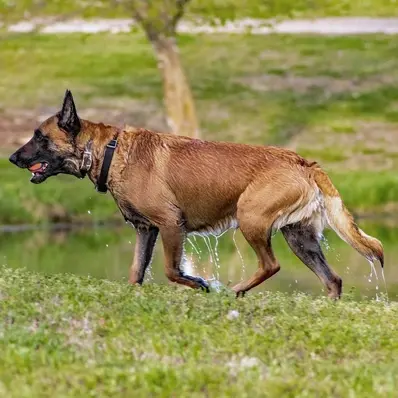Belgian Malinois History/Origin
The Belgian Malinois is one of four types of Belgian Sheepdog, originating in Belgium in the late 1800s. It is recognized by the American Kennel Club (AKC) under the Herding Group. They were developed for herding and guarding tasks. While all four varieties are similar in appearance, they have different coat lengths and colors. The Malinois, with its fawn-mahogany coat and short hair, became associated with the city of Malines due to its popularity there.
Belgian Sheepdog- Source: AKC.org
In the early 1900s, Malinois gained recognition for their intelligence and obedience in field trials. They were also utilized as guard dogs, draft dogs, and even by the military during World War I. Two Malinois came to the U.S. in 1911.
Other Malinois followed from the best European breeding stock. The outbreak of World War II stopped any more from coming in. Despite a decline in popularity during the Great Depression, they regained attention in the 1960s.
In 2011, a Navy SEAL team, assisted by Belgian Malinois, captured terrorist Osama Bin Laden in Pakistan. Today, Belgian Malinois are highly regarded for their work in various fields such as the military, law enforcement, and search and rescue operations. They continue to be imported to the U.S., with notable individuals like Conan gaining recognition for their heroic actions.
Belgian Malinois Personality
Belgian Malinois puppies are usually playful and curious like to meet new people, and enjoy being held. They’re loving with their family but may be cautious around strangers until they get to know them. These dogs are confident and protective, making great watchdogs without being overly aggressive.
These purebred dogs have a natural herding instinct to control the movement of other animals, such as moving objects like sheep or cattle. They display behaviors like circling and chasing to gather and move these objects.
- Belgian Malinois Temperament
Belgian Malinois are impulsive, and they can get themselves into trouble quickly. They are athletic, fast, and driven. Even if they are friendly, they are often way too much for the average family member or friend to manage.
Proper training and socialization from an early age are important for shaping their temperament. Exposing them to different people, places, and experiences while they’re young helps them grow into well-rounded adults. Puppy kindergarten classes and regular outings to meet new people and places are helpful for their social development.
Belgian Malinois Physical Appearance
The Belgian Malinois is one of the dog breeds that have a strong and fit dog, standing out for its athleticism among other breeds. It has a muscular body and a smart, alert look, showing both strength and agility.
- Size
The Belgian Malinois is a square-shaped dog, typically standing about 22 to 26 inches tall, appearing elegant and proud. They are strong, agile, and full of energy, with well-built muscles. They can handle tough weather in Belgium and stand firmly on all fours. They look solid without being bulky and have a confident expression, showing their heritage as herding dogs.
- Coat Color
Malinois have short, straight hair that feels hard to the touch. Their fur commonly comes in shades of fawn-mahogany, though it can also be darker or lighter.
Belgian Malinois are often compared to German Shepherds, as they share similar origins and purposes. However, there are some differences between these two breeds.
Here’s a quick look at Belgian Malinois vs. German Shepherd:
| Characteristic | Belgian Malinois | German Shepherd |
| Origin | Belgium | Germany |
| Purpose | Herding, Police Work | Herding, Police Work |
| Size | Medium-Large | Medium-Large |
| Weight | 60-80 pounds | 50-90 pounds |
| Coat Color | Fawn-Mahogany | Black and Tan |
| Coat Type | Short | Double Coat |
| Temperament | Intelligent, Loyal | Intelligent, Loyal |
| Energy Levels | High | High |
| Trainability | Highly Trainable | Highly Trainable |
Belgian Malinois Gender Differences
If you’re considering adopting a Belgian Malinois, you might be wondering whether you should get a male or a female. While both genders make great pets, there are some notable differences between them.
Here’s what you need to know about the gender differences of Belgian Malinois.
- Size Differences
The most noticeable difference between male and female Belgian Malinois is their size.
Female Belgian Malinois typically stand 22–24 inches tall and weigh between 40–60 pounds as adults, while males of the breed are 24–26 inches in height but weigh between 60–80 pounds on average.
However, remember that larger dogs also require more exercise, so be prepared to provide plenty of opportunities for your dog to run and play.
- Temperament Differences
Another significant difference between male and female dogs is their temperament.
Male Belgian Malinois tend to be more adventurous and energetic, often displaying a high-spirited and sometimes unruly demeanor. They can be stubborn and may require firm guidance from their owner, with a tendency towards territorial behavior and jealousy.
Females, on the other hand, mature more quickly and are easier to train, with a gentler and more focused nature. Female Belgian Malinois may be cautious around strangers and other dogs, which makes them good watchdogs. However, they adjust easily to new environments and are unlikely to show aggression towards other female dogs.
Belgian Malinois Feed/Nutrition
For Belgian Malinois, it’s important to feed them high-quality dog food, either store-bought or homemade, with your vet’s approval. Make sure the food matches their age, whether they’re a puppy, adult, or senior. Keep an eye on their weight and calorie intake, as some dogs tend to gain weight easily.
You can also offer oranges to your dog as an occasional treat, but be sure to remove the seeds and serve in moderation.
Treats can be helpful for training, but don’t overdo it to avoid obesity. Be aware of which human foods are safe for dogs, and always have clean water available. If you’re unsure about your dog’s weight or diet, consult your vet.
The general rule of thumb is to feed your Belgian Malinois 3 cups of dry food per day, divided into two meals. However, it’s important to consult your veterinarian to find out what’s best for your dog since every dog is different.
Belgian Malinois Health
Belgian Malinois are generally healthy, particularly those bred by responsible breeders who check for genetic diseases. However, like all breeds, they may encounter a few health issues during their lifetime.
- Hip Dysplasia:One of the most common health problems afflicting Affenhuahuas is hip dysplasia. Hip dysplasia is a condition that results in the dislocation of the hip joint. This can cause a lot of pain for your dog and make it difficult for them to move around. If you think your dog may have hip dysplasia, it is important to take it to the vet as soon as possible so it can receive treatment.
- Progressive Retinal Atrophy: It is a degenerative eye condition that leads to blindness due to the loss of photoreceptors in the eye. It can be detected years before any signs of blindness appear. Despite losing vision, dogs can adapt and live fulfilling lives, although it’s best to avoid rearranging furniture to help them navigate their surroundings better.
- Elbow Dysplasia: This is a heritable condition common to large-breed dogs. It’s thought to be caused by different growth rates of the three bones that make up the dog’s elbow, causing joint laxity. This can lead to painful lameness. Your vet may recommend surgery to correct the problem or medication to control the pain.
Regular veterinary check-ups, attention to dental care, and awareness of breed-specific health concerns are essential elements of responsible Belgian Malinois ownership. By staying proactive in your pet’s health, you can provide them with a happy and comfortable life.
Belgian Malinois Care and Grooming
Belgian Malinois thrive in small spaces with ample exercise, adaptable to various climates. They should live indoors as part of the family. Belgian Malinois need daily off-leash time in a fenced area and 20-minute walks or jogs multiple times a day. Additionally, leash training your dog is important for safe and enjoyable walks, helping them develop good behavior in public spaces.
Teaching Malinois obedience keeps them happy. Puppies need special exercises, starting with puppy classes and short playtimes, increasing as they grow up.
Belgian Malinois have short coats that protect them from the weather. Their fur can be light brown to dark red with black markings. Weekly brushing helps manage year-round shedding. Baths should be given only as needed, and regular teeth brushing is essential.
Nail trimming maintains foot health. Starting to groom them early helps them get used to it, making it easier to care for them as they get older. Regular checks for skin and health issues during grooming sessions ensure their overall well-being.
Belgian Malinois Rescue Groups
If you think Belgian Malinois will make a good pet for you, consider adopting from rescue groups or shelters to provide a loving home for dogs in need.
Belgian Malinois Price
The average price for Belgian Malinois dogs varies on multiple factors and usually ranges from $300 to $2500. Here are some sites you can get a Belgian Malinois:
Interesting Facts
- The American Kennel Club recognized the Belgian Malinois in 1959.
- Belgian Malinois work with the elite Navy SEALs, like Cairo, helped capture Osama bin Laden in 2011.
Cairo- Source: Navy Special Welfare Command
Best For
Belgian Malinois are best suited for experienced and active owners who can provide them with the training, socialization, and exercise they need to thrive.
Top Names
| Male Belgian Malinois Names | Female Belgian Malinois Names |
| Thor | Luna |
| Max | Bella |
| Duke | Daisy |
| Rocky | Maya |
| Zeus | Roxy |









 Belgian Sheepdog- Source:
Belgian Sheepdog- Source: 

 Fawn Belgian Malinois- Source:
Fawn Belgian Malinois- Source:  Mahogany Belgian Malinois- Source:
Mahogany Belgian Malinois- Source:  Belgian Malinois – Source:
Belgian Malinois – Source:  German Shepherd- Source:
German Shepherd- Source: 
 Cairo- Source:
Cairo- Source: 






